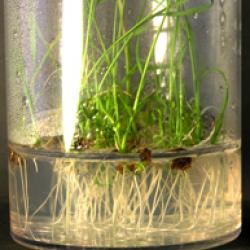Source Institutions
Source Institutions
Add to list Go to activity
Activity link broken? See if it's at the internet archive

In this activity related to plant biotechnology, learners use the tissue culture process to rapidly produce clones (genetic copies) of a particular plant (cauliflower, rose cuttings, African violet leaves, or carnation stems). This lab will help learners understand a procedure that is often used by scientists to propagate many plants of the same genetic background as well as to understand the importance of sterile techniques. Adult supervision recommended. This resource also contains background information and questions with answers for learners.
- 1 to 2 hours
- 1 to 12 months
- Over $20 per group of students
- Ages 11 - 18
- Activity, Demonstration, Experiment/Lab Activity, Lesson/Lesson Plan
- English
Quick Guide
Materials List (per group of students)
- 1 vial of Murashige Skoog (MS) medium
- 1 L sterile distilled water
- 8 g of agar/L
- 30 g sucrose/L
- 1.5-L or 2-L container in which to prepare the growth medium
- Small amounts of 1M NaOH and 1M HCl to adjust the pH of the medium
- 30 flat-bottom culture tubes with closures
- Glass aquarium or box lined with plastic
- Plastic sheet to cover the top of the aquarium
- Adhesive tape
- 10% bleach in a spray bottle
- 70% alcohol in a spray bottle
- Forceps or tweezers
- Gloves
- Cutting equipment such as a scalpel blade or razor blade
- 2 bottles of sterile distilled water (purchase at the grocery store)
- Pressure cooker
- Your chosen plant (cauliflower, rose, African violet, or carnation)
- Paper towel for cutting on, or sterile petri dishes if available
- Beaker or container in which to wash the plant material
- Detergent-water mixture - 1 ml detergent per liter of water
- Bleach sterilizing solution - dilute commercial bleach (5-6% sodium hypochlorite) to a final concentration of 1-2% sodium hypochlorite in distilled water in a large beaker or jar
- 2 or 3 beakers or containers of sterile water
- A well-lit area away from direct sunlight or use full-spectrum gro-lights
- Hormones such as BAP (benzylaminopurine) and NAA (naphthalene acetic acid) to stimulate growth and root development, respectively. (Commercial rooting hormone solutions and powders are also available from hardware stores.)
Subjects
-
Engineering and Technology
-
Engineering
- Agricultural Engineering
- Bioengineering/Biomedical Engineering
-
Technology
- Agriculture and Biotechnology
-
Engineering
-
Life Sciences
- Cells
-
Diversity of Life
- Plants
- Viruses and Bacteria
- Protists and Fungi
-
Heredity and Genetics
- Genetic Engineering
-
Mathematics
- Number and Operations
-
The Nature of Science
-
The Scientific Process
- Conducting Investigations
- Gathering Data
- Formulating Explanations
- Communicating Results
- Science as a Career
-
The Scientific Process
-
The Nature of Technology
-
Technology and Society
- Impacts of Technology
-
Technology and Society
Informal Categories
- Gardening
Audience
To use this activity, learners need to:
- see
- read
- touch
Learning styles supported:
- Involves hands-on or lab activities
Other
Components that are part of this resource:
This resource is part of:
Access Rights:
- Free access
By:
- Stephens, Janice ; Leach, Jan
Rights:
- All rights reserved, The American Phytopathological Society, 2011
